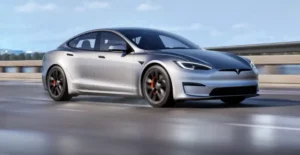Electric vehicles in Norway now account for 12% of new car sales. How can this be?
According to Opplysningsrådet for Veitrafikken, the Norwegian information council for road traffic, 12,079 cars were registered in November. Of those, 1,434 featured electric drive–almost 12 percent of the new car total. Most other countries struggle with sub one percent of EV sales.
As mentioned recently the Tesla Model S was Norway’s highest-selling car in September, with 616 units and an impressive 5.1 percent share of the market overall. Last month, reports Reuters, Nissan’s Leaf headed the car sales table, with 716 units–more than the Volkswagen Golf, at 646 cars. It took a 5.6 percent share of the market in October.
Norway’s electric car sales share was 8.6 percent of the market in September and 7.2 percent in October–with Leafs and Model S making up the majority of those sales.
Last month, reveals Best Selling Cars Blog, Tesla’s Model S once again scored highly, sitting in second spot with 527 sales. The Leaf has moved down to fifth with 512 units, while topping the chart is the ubiquitous VW Golf at 666.
November marks quite a jump then, and EVs now outsell hybrids in the country–with 849 units, hybrids accounted for an 8.9 percent share last month, and sales are 57 percent higher than they were last year.
That’s probably why Norway’s average CO2 output for new cars is dropping rapidly, averaging just 113 grams per kilometer of the greenhouse gas. For some perspective, that CO2 figure is barely more than the average small-engined subcompact car produces in European testing–and the high proportion of electric and hybrid vehicles has undoubtedly played a part.
There’s a very good reason electric cars are selling well in Norway of course–as well as providing a comprehensive recharging infrastructure and lavishing the cars with tax incentives and other benefits, EVs also avoid the heavy taxes applied to regular vehicles in the country.
This means a car like the Nissan Leaf costs no more than the equivalent Volkswagen Golf or Ford Focus.
And while Norway is a large, elongated country most of its habitable areas are located within short distance of Oslo. This means vehicles rarely embark upon long journeys, perfect for electric vehicle adoption.
In the greater scheme of things, 1,434 cars in November–or even the country’s total 12,000 vehicles–is a fairly small figure. In October, over 1.2 million vehicles were sold in the U.S.–a hundred times more than in Norway. But it’s proof that given the right market conditions, electric cars really can work very well indeed.
How do they do it in Norway? The answer is of course the old carrot and stick with Tax and incentives.
The country’s various subsidies for electric vehicles amount to as much as $8,200 per car–every single year.
That’s partly down to Norway’s heavy taxation, which sees the prices of regular cars pushed significantly higher than they are elsewhere. A basic Volkswagen Golf, that costs the equivalent of $24,600 in the United Kingdom, can cost $42,000 in Norway.
While a Nissan Leaf is still cheaper in the UK than it is in Norway, at $35,500, in comparison to that same VW Golf, the price looks much more attractive–$42,500.
You can bet Nissan Leafs would sell quicker in the U.S. if they cost only $500 more than an equivalent gasoline car, that’s for sure.
The tax breaks on purchase amount to around $1,400 per year over a car’s lifetime, according to a study by Statistics Norway analyst Bjart Holtsmark. To this, the average driver can add $1,400 in road toll savings, free parking worth $5,000 and avoid other charges of around $400. All those figures are per year savings.
In addition, electric car drivers can save time as well as money–as they’re allowed to use the country’s bus lanes, denied to normal traffic.
These incentives will run until 2017, when the scheme will be reviewed.




